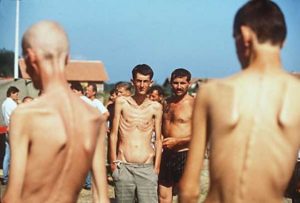The Bosnian War
The Bosnian War resulted in the death of around 100,000 people, and the displacement of over two million men, women and children.

Bosnian and Croatian prisoners of war at the Serbian run prison camp in Trnopolje, Bosnia. © Ron Haviv – VII
A campaign of war crimes, ‘ethnic cleansing’ and genocide was perpetrated by Bosnian Serb troops under the orders of Slobodan Milošević. It is estimated that between 20-50,000 women were raped during the war in Bosnia, as part of a strategy of ethnic cleansing. The Croatian military also carried out war crimes and ‘ethnic cleansing’, on a lesser scale.
The Siege of Sarajevo
Sarajevo, the capital city of Bosnia was the scene of the longest siege in modern warfare. From April 1992 to February 1996, the city was encircled by the Serb-controlled army. Civilians endured shelling of their city for nearly four years and more than 10,000 people were killed. The Bosnian Serbs burnt down and destroyed cultural monuments, public meeting spaces and the National Library in the city.
Prijedor
From 1992, in the north-western Bosnian municipality of Prijedor, non-Serbs were forced to wear white armbands. The Serbian newspaper Kozarski Vjensnik began to publish propaganda on behalf of the Serb authorities. Radio Prijedor began to broadcast anti-Croat and anti-Bosniak propaganda and television stations began to broadcast interviews with radical Serbian leaders and pro-Serbian nationalistic songs which were previously banned.
After the takeover of power from the municipal Assembly by Serb forces, non-Serbs were sent to concentration camps. Women were taken to Trnopolje camp, where they were systematically raped on a regular basis and camp officers would beat all prisoners indiscriminately with whatever weapon came to hand. It is estimated that around 7,000 people passed through Trnopolje camp.
Around 3,500 people, mainly men, were held in inhumane conditions in the Omarska Camp, the largest of the concentration camps. The prisoners were given one meal per day and violence from the camp officers was widespread. Living conditions were atrocious, with suffocation caused by overcrowding being a constant threat to the prisoners. The camp was closed in August 1992 after a visit from foreign journalists. The surviving 1,500 prisoners were divided into groups and deported to different destinations.
The worst aspect of being kept in the Omarska Camp was the fact that the place was guarded by my former schoolmates, former neighbours, former policeman on whose protection I relied before the War, and even former teachers.
– Kemal Pervanić
Refugees
Over two million people were displaced by the collapse of Yugoslavia.
As Serbian forces began their campaign of ‘ethnic cleansing’ non-Serbs were forced out of their communities and their homes were destroyed. They had to carry what little possessions they could manage. A UN report judged that ‘murder, torture, arbitrary arrest and detention, extra-judicial executions, rape and sexual assaults, confinement of civilian population in ghetto areas, forcible removal, displacement and deportation of civilian population, deliberate military attacks or threats of attacks on civilians and civilian areas, and wanton destruction of property’ were methods used to carry out ‘ethnic cleansing’ during the Bosnian War.
In 1995, towards the end of the war, the Croatian army carried out its own campaign of ‘ethnic cleansing’ against Serbs in the Krajina border region of Croatia. It is estimated that 300,000 Croatian Serbs were displaced throughout the crisis, and, to date only around a third of those refugees have returned to their former homes.
After Radovan Karadzic was convicted of crimes against humanity in 2016, many Bosnian refugees chose to return home, after twenty years abroad.